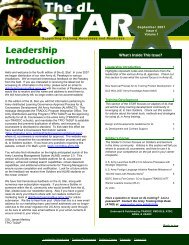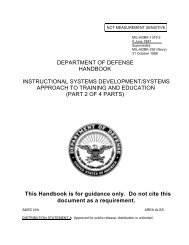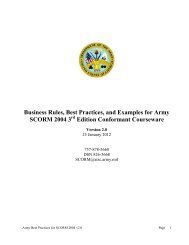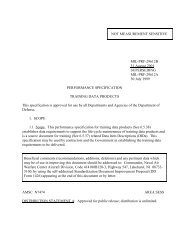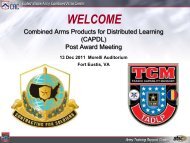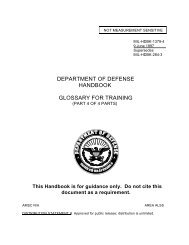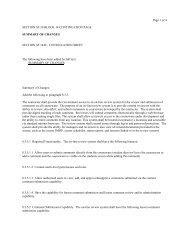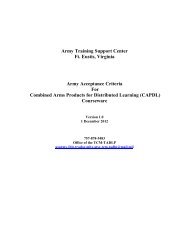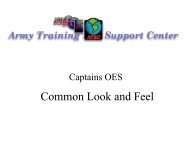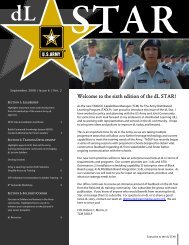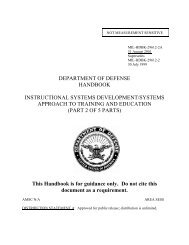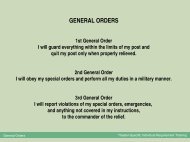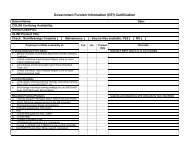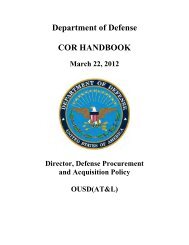Download - U. S. Army Training Support Center
Download - U. S. Army Training Support Center
Download - U. S. Army Training Support Center
Create successful ePaper yourself
Turn your PDF publications into a flip-book with our unique Google optimized e-Paper software.
on a device that they are used to using. The<br />
digital learning content developed last year<br />
was based on Program of Instruction (POI)<br />
“trouble spots” or material that gave many students<br />
problems as indicated by MCoE training<br />
unit Subject Matter Experts (SMEs). So in addition<br />
to the potential for the digital learning<br />
content to eliminate personal performance<br />
gaps, the digital training applications have the<br />
ability to provide a Soldier coming to training<br />
at the MCoE a “head start” on those POI problem<br />
areas. Moreover, since the content has<br />
the potential for implementation on a desktop<br />
or laptop personal computer, the same training<br />
aid used before coming to the course can be<br />
used during the course.<br />
The development of a digital training application<br />
not only support the institutional and the<br />
self-development domains, but support the<br />
Soldier in the operational domain. <strong>Army</strong> educators<br />
should accept the notion that most Soldiers<br />
have access to a “smart device” whether<br />
that device is a phone or a tablet. SFC Mikeal<br />
McInroy confirms that notion when discussing<br />
his requirement for the development of digital<br />
application when he explained that he uses<br />
such devices and the MCoE digital applications<br />
in training. He described the abundance<br />
of such devises in the <strong>Army</strong> as “everyone having<br />
one” (personal communications, December<br />
7, 2012).<br />
The MCoE digital learning content design<br />
does not follow the 10- to 15-minute standard<br />
for mobile learning as advocated by some instructional<br />
designers of e-learning content. The<br />
design of our digital training applications provides<br />
the learner with the means to work in a<br />
topic area of personal interest and explore other<br />
areas of interest in the training. The design of<br />
the applications is meant to allow the learner to<br />
move in and out of the digital learning application<br />
as they need. Also, several of our digital<br />
training applications are job aids. For example,<br />
we have developed a tank screening application<br />
that allows the user to input corrections<br />
data, which then provides the data for input into<br />
the tank’s computer. The corrections sheet can<br />
be e-mailed to the battalion master gunner.<br />
Many reading this understand the complexity of<br />
“going mobile.” In order for the education community<br />
to achieve the goals of the ALM 2015,<br />
specifically when it comes to the principles of<br />
adaptive and personalized learning, they must<br />
provide the content that is “acceptable” to the<br />
user and implemented on a device they choose.<br />
We have added to the complexity of “going mobile”<br />
by including the requirement to bring the<br />
mobile content to the classroom via a personal<br />
computer. One of the most complex issues associated<br />
with implementation is that of not having<br />
an <strong>Army</strong>-specific server for digital learning



